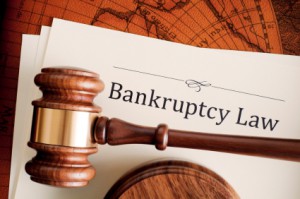 As I am writing this article I need to make one thing clear. I am NOT a bankruptcy attorney. However, I have to deal with bankruptcy on a regular basis. I might have a client who has an open account with a debtor who has filed bankruptcy. A bank may have a secured mortgage loan with a customer who has abandoned the residence and filed bankruptcy. A landlord may have a tenant who is past due on rent and then files bankruptcy. Unfortunately, these types of circumstances drag me into the realm of bankruptcy law.
As I am writing this article I need to make one thing clear. I am NOT a bankruptcy attorney. However, I have to deal with bankruptcy on a regular basis. I might have a client who has an open account with a debtor who has filed bankruptcy. A bank may have a secured mortgage loan with a customer who has abandoned the residence and filed bankruptcy. A landlord may have a tenant who is past due on rent and then files bankruptcy. Unfortunately, these types of circumstances drag me into the realm of bankruptcy law.
Article I, Section 8 of the United States Constitution authorizes Congress to enact “uniform Laws on the subject of Bankruptcies.” Our founding fathers anticipated bankruptcy would somehow be a part of our Country’s future. Under this grant of constitutional authority, Congress has enacted a Bankruptcy Code which is codified in Title 11 of the United States Code.
Each state has one or more judicial districts for bankruptcy. There are 90 bankruptcy districts across the United States. Indiana is divided into a Northern District and a Southern District. Montgomery County falls under the jurisdiction of the Southern District of Indiana.
There are six basic types of bankruptcy cases under the Bankruptcy Code. These types of bankruptcies are described as follows:
1. Chapter 7 is entitled Liquidation, which contemplates a Court supervised procedure by which a Trustee takes over assets of the debtor’s bankruptcy estate, reduces them into cash and makes distributions to creditors. A debtor has a right to retain certain exempt property. In a majority of Chapter 7 cases there is usually little or no non-exempt property and there is not an actual liquidation of assets. These cases are called “no asset cases.” In most Chapter 7 cases, if a debtor is an individual then he or she will receive a discharge that releases them from personal liability for most dischargeable debts. In order to qualify for Chapter 7, a debtor must pass a “means test” to determine if the debtor qualifies for Chapter 7 relief. If a debtor’s income is in excess of certain thresholds, Chapter 7 relief may not be available.
2. Chapter 9 provides for a municipality such as a city or school district to reorganize its debts and finances. Chapter 9 is only available to governmental entities.
3. Chapter 11 is entitled Reorganization, and is mostly used by commercial enterprises which desire to continue to operate a businesses and the repay creditors concurrently through a Court approved plan of reorganization. Under Chapter 11, a debtor has the exclusive right to file a plan of reorganization the first 120 days after the bankruptcy is commenced and provide adequate information to creditors so the reorganization plan can be evaluated. The Bankruptcy Court ultimately confirms or disapproves the plan of reorganization. Creditors can object to the plan. A debtor can terminate burdensome contracts, recover assets and restart its operations in hope of returning to profitability. Chapter 11 typically allows a debtor to go through a period of consolidation, emerge with a reduced debt load and reorganize its business.
4. Chapter 12 provides debt relief to family farmers and fishermen with regular income. Under Chapter 12, a debtor proposes a plan to repay debts over a period of time, usually three to five years. Chapter 12 allows a family farmer or fisherman to continue to operate the business while the plan is being carried out.
5. Chapter 13 is designed for an individual debtor who has a regular source of income to pay debts over a period of time. Chapter 13 enables a debtor to keep a valuable asset because it allows the debtor to propose a plan to repay creditors over a period of time – usually three to five years. At a confirmation hearing, the Bankruptcy Court either approves of disapproves a debtor’s repayment plan depending upon whether it meets statutory requirements. Chapter 13 allows a debtor to remain in possession of property and make payments to creditors, usually through the Trustee, based upon the debtor’s anticipated income over the life of the plan. If a debtor fails to abide by the terms of his/her plan, then the bankruptcy can be dismissed.
6. Chapter 15 provides a mechanism for dealing with cases of across border insolvencies. Typically, Chapter 15 involves a debtor who is subject to the laws of the United States and one or more foreign countries.
I need to mention one special characteristic of a bankruptcy filing. When a petition for bankruptcy is filed an “automatic stay” comes into play. This means that a creditor cannot take any action to enforce its debt while the automatic stay is in effect. If you receive a bankruptcy notice from someone who owes you money, DO NOT take any action to collect on that debt.
If you violate a bankruptcy stay, you can be subject to fines, penalties and attorney fees.
If you are a creditor trying to collect a debt, there are few things more irritating than receiving a bankruptcy notice. If you are a debtor who has filed for bankruptcy, it gives you a new opportunity to rebuild your financial life. Bankruptcy has been around since the founding of the USA. Seek appropriate legal counsel when dealing with this 200 year old concept.
This article is published for information purposes only. It is not intended nor is it to be used as a substitute for independent legal advice.
Stu Weliever practices law with HENTHORN, HARRIS & WELIEVER, P.C., 122 E Main St, Crawfordsville, Indiana, and can be reached at (765) 362-4440 or at stuw@henthornlaw.com.

